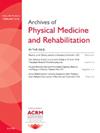Deborah L. Wilkerson Early Career Award: Using Clinical Data to Understand Recovery Trajectories and Optimize Patient Care
IF 3.6
2区 医学
Q1 REHABILITATION
Archives of physical medicine and rehabilitation
Pub Date : 2025-04-01
DOI:10.1016/j.apmr.2025.01.053
引用次数: 0
Abstract
Objectives
For the Deborah L. Wilkerson Award, Dr Alison M. Cogan will report on study that aimed to examine the associations among the time and content of rehabilitation treatment with patient rate of gain in self-care and mobility for adults with acquired brain injury. In the context of the shift to value-based payments for postacute rehabilitation services, it is critical to be able to demonstrate how specific rehabilitation services drive change on relevant patient outcomes.
Design
Retrospective cohort study using electronic health record and billing data. Our team extracted demographic data, functional measures at admission and discharge, and all billed therapy services for patients’ first rehabilitation admission following a brain injury or stroke event.
Setting
Inpatient rehabilitation unit at a large academic medical center.
Participants
A total of 799 (N=799) adults with acquired brain injury who received inpatient rehabilitation services.
Interventions
Standard rehabilitation therapy.
Main Outcome Measures
Average change in self-care and mobility items from the Functional Independence Measure per length of stay day.
Results
Median length of rehabilitation stay was 10 days (interquartile range, 8-13d). Patients received 10.62 units of therapy (SD, 2.05) per day, on average. For self-care care gain per day, the best fitting model accounted for 32% of the variance. Only occupational therapy activities of daily living units were positively associated with gain rate. For mobility gain per day, the best fitting model accounted for 37% of the variance. Higher amounts of physical therapy bed mobility training were inversely associated with both self-care and mobility gain rate.
Conclusions
The transition to a value-based payment model in IRFs will shift more risk of patient outcomes to therapists, and facilities will need to make decisions about costs and service delivery to produce optimal results. In this changing context, rehabilitation teams have an opportunity to utilize their data to support informed decisions about what kinds of rehabilitation therapy drive improved patient outcomes, thus generating better value for patients and meeting facility goals. Dr Cogan will also discuss the benefits and challenges of using electronic health record data in research.
Disclosures
none.
Deborah L. Wilkerson早期职业奖:使用临床数据了解康复轨迹并优化患者护理
为了获得Deborah L. Wilkerson奖,Alison M. Cogan博士将报告一项研究,旨在研究康复治疗的时间和内容与获得性脑损伤成人患者自我护理和活动能力提高率之间的关系。在急性期后康复服务转向基于价值的支付的背景下,能够证明特定的康复服务如何推动相关患者结果的变化是至关重要的。设计使用电子健康记录和账单数据的回顾性队列研究。我们的团队提取了人口统计数据,入院和出院时的功能测量,以及脑损伤或中风事件后患者首次康复入院的所有收费治疗服务。大型学术医疗中心的住院康复部。参与者共799名(N=799)接受住院康复服务的获得性脑损伤成人。干预措施:标准康复治疗。主要结果测量:每个住院日的自理能力和活动能力项目的平均变化。结果康复住院时间中位数为10天(四分位数间8 ~ 13天)。患者平均每天接受10.62个单位的治疗(SD, 2.05)。对于每天的自我照顾,最佳拟合模型占方差的32%。只有日常生活单位的职业治疗活动与增重率呈正相关。对于每天的活动能力增加,最佳拟合模型占方差的37%。高量的物理治疗床上活动能力训练与自我保健和活动能力增加率呈负相关。irf向基于价值的支付模式的转变将把更多的患者结果风险转移给治疗师,机构将需要对成本和服务提供做出决策,以产生最佳结果。在这种不断变化的背景下,康复团队有机会利用他们的数据来支持明智的决定,即什么样的康复治疗可以改善患者的治疗效果,从而为患者创造更好的价值,并实现机构的目标。Cogan博士还将讨论在研究中使用电子健康记录数据的好处和挑战。
本文章由计算机程序翻译,如有差异,请以英文原文为准。
求助全文
约1分钟内获得全文
求助全文
来源期刊
CiteScore
6.20
自引率
4.70%
发文量
495
审稿时长
38 days
期刊介绍:
The Archives of Physical Medicine and Rehabilitation publishes original, peer-reviewed research and clinical reports on important trends and developments in physical medicine and rehabilitation and related fields. This international journal brings researchers and clinicians authoritative information on the therapeutic utilization of physical, behavioral and pharmaceutical agents in providing comprehensive care for individuals with chronic illness and disabilities.
Archives began publication in 1920, publishes monthly, and is the official journal of the American Congress of Rehabilitation Medicine. Its papers are cited more often than any other rehabilitation journal.

 求助内容:
求助内容: 应助结果提醒方式:
应助结果提醒方式:


